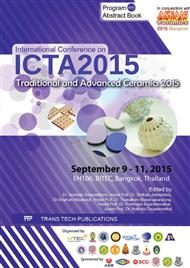p.6
p.12
p.18
p.23
p.28
p.33
p.39
p.45
p.51
Effect of Frit Content on the Metal Marking and Scratching Resistance of Celadon Glaze
Abstract:
Metal marking and scratching are related to surface roughness, hardness and toughness of glaze. To improve the glaze properties, frits were added in the traditional celadon glaze and reducing firing atmosphere was controlled. Surface roughness of celadon glaze was decreased with increasing the reducing agent content (LPG flowing rate) and increasing the frits content. Though hardness of glaze without frit was increased with increasing the reducing agent content, hardness of glaze with frit was not changed extremely with increasing the reducing agent content. To evaluate the metal marking and scratching resistance, wear resistance test was used with stainless steel ball. After wear test, many metal marks and wide scratching trace were observed in the traditional celadon glaze. However, a few metal mark and scratch were observed in the celadon glaze with frit. The friction coefficient of glaze in the wear test was strongly depended on the frit contents.
Info:
Periodical:
Pages:
28-32
Citation:
Online since:
May 2016
Authors:
Keywords:
Price:
Сopyright:
© 2016 Trans Tech Publications Ltd. All Rights Reserved
Share:
Citation:


